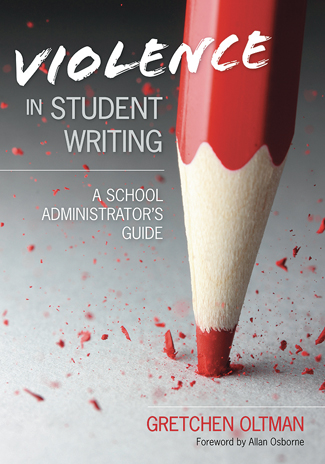
Violence in Student Writing: A School Administrator’s Guide
Corwin
118 pages
When Gretchen Oltman began teaching English literature to “a rough crowd” of Nebraska high school juniors and seniors in 1999, she assigned them to write her a letter about themselves. One letter stood out: “I am the worst person you’ll ever meet. I like to pa-a-a-a-rty and shoot guns. I would watch out if I were you.”
Just four months after the Columbine High School shooting in Colorado, Oltman didn’t know how to respond to this threat. In 2010, a student shot two school administrators just 15 miles from her home.
Now Oltman combines her expertise as an attorney and a writing teacher to offer sound advice for creating school policy and classroom practices that promote school safety. She makes a distinction between student violent writing – dark or gruesome “expression by an otherwise harmless student” – and violent student writing from “disturbed and dangerous individuals.”
The “Columbine effect” – a “new term,” Oltman explains, that appeared in descriptions of “litigation spawned by the shootings” – triggered a national wave of student expulsions for violent writing. One Rhode Island seventh grader was interrogated by the Secret Service for writing that his “perfect day” included harming the president and Oprah.
Oltman recommends assessing student violent writing in relation to the four Supreme Court rulings that govern student expression: Depending on the circumstances, Tinker v. Des Moines Independent School District (1969), Bethel v. Fraser (1986), Hazelwood v. Kuhlmeier (1988) and Morse v. Frederick (2007) each contribute to the interpretation of protected speech. Case law from lower courts adds considerations regarding a school’s culture. Oltman concludes that schools can discipline students for the content of their writing, especially if it appears on school property and is a type of expression restricted in Court rulings.
Oltman is critical of zero-tolerance policies requiring automatic punishment – “no investigation, no conversations, no teachable moments.” Some seem ludicrous, such as a Florida student’s 10-day suspension for loaning her nail file to a friend. Instead, administrators must ask questions about violent writing: What was the teacher’s rationale for the assignment? What was the student’s motivation?
A sidebar in the book shows common emotions – from being bullied to having suicidal thoughts – that have led to students’ violent writings. Oltman provides sample school policies, recommending that they should “incorporate a statement that truly threatening speech is not protected speech and will not be tolerated within the school environment.”
Violent writing “can emerge anywhere,” in journals, notes to friends, assignments about tough issues, or on the Web. “The problem lies with the few students who express violent thoughts and may or may not consider carrying those thoughts into action,” writes Oltman. A list of seven warning signs of a troubled teen ranges from “making a direct threat about harming or killing others” to “preferring isolation.” Yet it is “impossible to know for sure which student who writes about violent content will act on it and which student will not,” she notes.
Oltman recommends that a teacher or administrator should discuss in detail with a student why he wrote a violent essay. Classroom guidelines could set limits on what may be written, and a printed policy about violent writing could be shared with administrators, parents and students.
Outside the classroom, student violent writing often occurs online in instant messages, texting and social media postings that target peers or adults at school. “Courts across the country are divided” on whether schools can discipline students for writings outside school, Oltman reports. One U.S. Federal Court of Appeals protected expression in two cases in 2010, both involving students’ MySpace parody pages that insulted school principals.
Although cyberbullying happens online, school administrators can discipline student perpetrators if the writing is threatening or “disturbs the educational process.” Effects on victims can be crushing; there’s a limitless audience and no escape at school or home. The cyberbully often remains anonymous. Researchers who have studied the use of school-wide cyberbullying prevention programs recommend them as effective.
Online or on paper, violent writings that target teachers or school administrators are difficult to endure. Oltman counsels how to cope with situations such as an Arizona teacher’s cruel harassment by her junior high students, who listed methods for killing her. Administrators must have a clear plan for handling students’ violent writing incidents while protecting student rights and safety. Teachers must explain to students that “violent, graphic, obscene, or disruptive writing” will be forwarded to the administration. Administrators and faculty can create “a mock student violent writing episode” and practice their responses to work out kinks.
Revealing the gravity of such situations, Oltman provides a sample threat assessment form and an eight-step technique to analyze students’ violent writings. The writer is interviewed about his motivations. Questions are included for parents and the person who discovered the writing, along with directions for consulting with mental health or law enforcement personnel.
Formatted for easy reference, this book has bold headings, bullet points and summaries. Oltman’s clear focus is not well served by long paragraphs that obscure valuable information, but the index helps, and Oltman’s authority for her topic rewards study. Every chapter lists a wealth of positive strategies to use with students: Grades K-6 could earn Good Citizenship awards, for example, while grades 7-12 might enter poster contests promoting First Amendment principles. Chapters end with questions that prompt action or reflection, such as: “What are you doing to combat cyberbullying?” and “Are you emotionally prepared to respond to a student violent writing incident?”
In a concluding plea for action, Oltman writes, “All student violent writing will require some type of response, from a brief investigation by a classroom teacher to a thorough review by law enforcement.” Urging every school to have a protocol in place before an incident occurs, she also recommends conflict-resolution sessions for all students.
Outside schools, anyone who connects with youth – parents, mental health counselors and leaders of after-school programs or youth organizations – can become aware of the signs and dynamics in students’ violent writing. Oltman’s advocacy for youth is contagious.
Contact: corwin.com.































